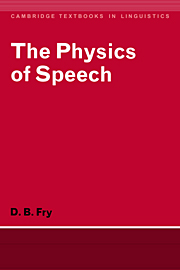Book contents
- Frontmatter
- Contents
- List of phonetic symbols
- 1 The speech chain
- 2 The generation of sound
- 3 The propagation of sound waves
- 4 Absorption and reflection of sound energy
- 5 Free and forced vibrations: resonance
- 6 The speech mechanism as sound generator
- 7 The vocal tract
- 8 Periodic and aperiodic sounds
- 9 Acoustic analysis: the sound spectrograph
- 10 Acoustic features of English sounds
- 11 Acoustic cues for the recognition of speech sounds
- Index
- Frontmatter
- Contents
- List of phonetic symbols
- 1 The speech chain
- 2 The generation of sound
- 3 The propagation of sound waves
- 4 Absorption and reflection of sound energy
- 5 Free and forced vibrations: resonance
- 6 The speech mechanism as sound generator
- 7 The vocal tract
- 8 Periodic and aperiodic sounds
- 9 Acoustic analysis: the sound spectrograph
- 10 Acoustic features of English sounds
- 11 Acoustic cues for the recognition of speech sounds
- Index
Summary
When two people are talking to each other, a great deal of activity of many different kinds is going on in both of them. The most vital part of this is taking place in their brains because this is where they have stored away all the knowledge about the language they are using, which is indispensable for communication by speech. In the speech centres of the brain we carry information about the phonological system of the language, that is the significant differences in speech sounds, in intonation and in rhythmic pattern, about the grammatical and syntactic procedures which govern our speech and the very extensive vocabulary that we call on when we are taking in speech or sending it out. The whole time anyone is speaking, his brain is busy putting into language form whatever it is he wants to say, that is it is choosing words from the dictionary carried in the cortex, arranging the form of the remark and putting the words in the appropriate order, inserting the grammatical elements and form words, and stringing together the phonemes which make up the message. In addition to all this purely linguistic work, his brain is sending out a continuous flow of operating instructions which go to the many different muscles involved in making the skilled movements of speech.
- Type
- Chapter
- Information
- The Physics of Speech , pp. 1 - 4Publisher: Cambridge University PressPrint publication year: 1979
- 3
- Cited by

